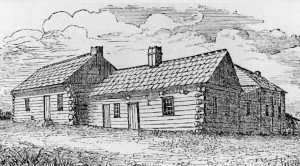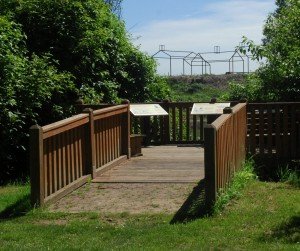Undated drawing shows front of mission.
Almost thirty years after the Lewis and Clark Expedition, four desperate Northwest Indians trekked half way across the continent to ask General Clark for his “Book of Heaven”, hoping to save their people from disease and poverty. Alerted by a sympathetic article in the Christian Advocate, the Methodist evangelical spirit responded by financing a missionary effort to Oregon led Jason Lee. His nephew, Daniel Lee, was selected to be his assistant missionary, and Cyrus Shepard was appointed as lay missionary. With the addition of two other laymen, Philip Edwards and Courtney Walker, the small party prepared to cross the continent into a fate none could have imaged.
The 1834 overland expedition was guided by Nathaniel Wyeth, a successful Boston businessman hoping to establish western fur and dried salmon trading posts and, from Fort Hall to Fort Vancouver, by Thomas McKay, stepson of John McLoughlin, who was a Hudson Bay Company brigade leader and explorer of the Columbia River area. The Methodist mission was organized in the Willamette Valley near a French Canadian settlement, about ten miles north of the present city of Salem. In contrast to the trader/trapper attitude of living in concert with the Indians, the Americans wished, through their preaching classes for the Indian children, to “civilize” the native people by their own standards of society. As examples, the Methodist sponsors realized that American women were needed in the mission community to serve as teachers and to establish families. Aside from these practical matters, one can imagine that the young missionary gentleman were as eager to seek the comfort of women as had the retired French-Canadian trappers living nearby and to attain female help for household domestic activities in their rough frontier cabins. The Methodists recognized that, even if one of their missionaries sought Christian marriage with a native women of the area, it would not be recognized if they returned to their former homes “in the states.” There was also the general observation that native women, if they displeased with their male companions, would simply leave them. The ceremony of marriage was a necessity, and with American women who understood the duties of the institution.
The Board of Missions of the New England Conference of the Methodist Church responded by sending five women who volunteered to be in the next group of missionaries sailing in two whaling vessels from Boston in the summer of 1836. The year-long voyages, including several months in the Sandwich Islands (Hawaii), ended in Fort Vancouver (near the present city of Portland, Oregon) in May and September of 1837. The travelers proceeded by canoes for three days to the landing at Champoeg where horses were obtained carry them to the mission settlement on the Willamette River about 10 miles north of the present city of Salem. This route took them over the potential rich farmlands of “La Jolie Prairie”, now known as the historic French Prairie area between the two cities. Among the voyagers were three families: a future leader of the missionary community, David Leslie, arrived with his wife Mary and three daughters; a much-needed blacksmith, Anson Beers, with his wife Rachel and three children; and Dr. Elijah White, his wife Serepta and adopted son. A carpenter, William Willson, who had learned medical skills from Dr. White, came as a bachelor. Two of the four unmarried women of the group were already engaged: Susan Downing, to Cyrus Shepherd, a teacher at the mission and Elvira Johnson to minister H. K. Perkins. The Methodist church sponsors hoped that Anna Maria Pittman, acquainted with Jason Lee, would become his wife. Margaret Smith, an experienced teacher, was alone determined to continue unmarried in her profession.
The future of these seven women would be revealed in the frontier life of the structures seen above.


